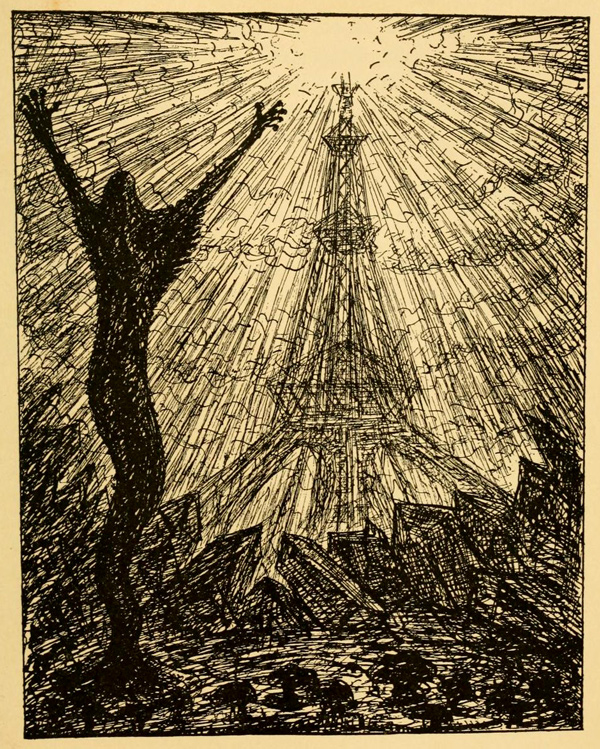(Find me at 50 Watts Books.)
Alfred Kubin's illustrations for Paul Scheerbart's Lesabéndio: An Asteroid Novel (1913)

"Slowly, Lesabéndio floated into the depths, with his suction-foot still tucked behind his head."
Posted to coincide with Matthew Jakubowski's profile of Paul Scheerbart on my other blog Writers No One Reads.
The scans in this post came from archive.org, though note that the new English translation of Lesabéndio includes much better reproductions.
For more of Alfred Kubin's work from this time, check out my posts on Der Orchideengarten. (These yellow-with-age illustrations in fact make me nostalgic for the weeks in 2009 I spent scanning the Orchid Garden.)
Wakefield Press copy for their edition:
First published in German in 1913 and widely considered to be Paul Scheerbart's masterpiece, Lesabéndio is an intergalactic utopian novel that describes life on the planetoid Pallas, where rubbery suction-footed life forms with telescopic eyes smoke bubble-weed in mushroom meadows under violet skies and green stars. Amid the conveyor-belt highways and lighthouses weaving together the mountains and valleys, a visionary named Lesabéndio hatches a plan to build a 44-mile-high tower and employ architecture to connect the two halves of their double star. A cosmic ecological fable, Scheerbart’s novel was admired by such architects as Bruno Taut and Walter Gropius, and such thinkers as Walter Benjamin and Gershom Scholem (whose wedding present to Benjamin was a copy of Lesabéndio). Benjamin had intended to devote the concluding section of his lost manuscript The True Politician to a discussion of the positive political possibilities embedded in Scheerbart’s “Asteroid Novel.” As translator Christina Svendsen writes in her introduction, “Lesabéndio helps us imagine an ecological politics more daring than the conservative politics of preservation, even as it reminds us that we are part of a larger galactic set of interrelationships.”

"The studio terraces were also lively because Pallasians sprang constantly through the colonnades or jumped out from behind columns. Using their dorsal wings, they moved between higher and lower balconies."

"Each of the seven Pallasians was holding a heavy lead hammer with a long shaft. With their hammers, the seven hammered on a single nut with their full strength, until suddenly there was a loud crack—and the seven jumped back."

"Biba was silent and smoked his bubble-weed, letting countless numbers of little blister-bubbles fly through his puckered lips. They soon grew in size and lit up the area as they eddied about the cave."

"The Pallasians should allow themselves to be tied tightly to the end of one of the planet's tentacles, so that, at just the right moment of maximum rotational speed, they could be cut loose from the star and flung out into space, in the direction of their home planet."

"While perching on the model tower, all the Pallasians—with the exception of Lesabendio—vote for the construction of the giant tower. Lesabendio arrives too late."

"And—and—my salve has been used up. I don't know how I'll be able to make any more. It's become completely impossible for me to create liquids."

"Lesabendio fell asleep. He dreamed of an enormous solar system—and it appeared to him like a system of millions of rubber bands that were continuously being stretched apart and then rebounding back together again."

"Nax was silent, jiggling his proboscis."

"The consequence of this answer of theirs, however, was that every Pallasian suddenly only wanted to live on the great tower."

"I want to be absorbed into Lesa, who destroyed me. Maybe that way, something of what I have thought will remain behind on Pallas."

"They brought the model out of the workshop on iron rails and wheels."

"The final preparations for Lesabendio's ascent are made. On the uppermost balcony, Lesa gives Biba a few more specific instructions."

"The tips of the beams touched the cloud, and the cloud began to tremble. A terrible thunder was audible."
***
Wakefield also includes two drawings by Scheerbart himself (below). My pal Arnold Mosselman recently directed me to scheerbart.de where you can see a ton of art by Scheerbart (at mostly small sizes for now).



great cover for Wakefield Press edition
Previously:
—Treatise on Elegant Publishing
—The Wily Grasser meets The Opium Eater

























